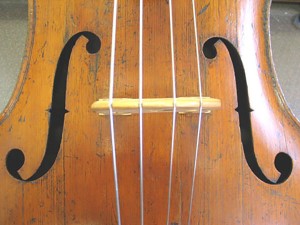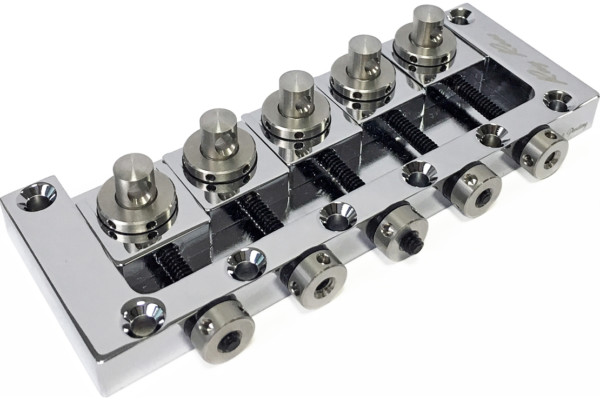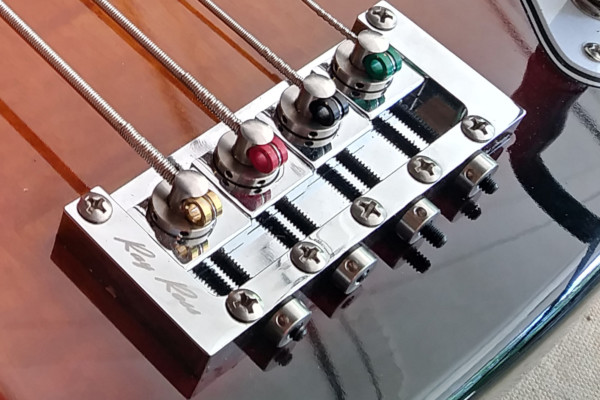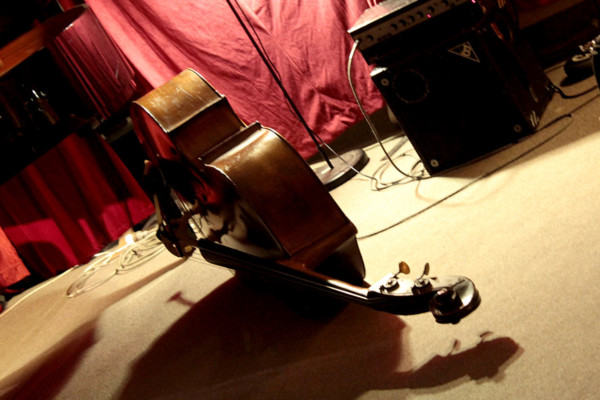Things to Know About the Bridge on Your Upright Bass
 Having a properly set up bridge on your upright is an important factor in the playability, sound and the long-term health of your instrument.
Having a properly set up bridge on your upright is an important factor in the playability, sound and the long-term health of your instrument.
Here are some things every upright player should know:
The internal, not external, notches you see on the F-holes determine the proper distance of the bridge from the fingerboard. They should correspond, more or less, to the center of each bridge foot. Furthermore the feet should be in a straight line from E side to G side. Bridges without height adjusters won’t generally have issues in this regard, but the feet of bridges with adjusters can become massively askew.
The distance from the F-holes should be equal for each foot. Meaning that the E-side of the bridge and the G-side of the bridge should be the same distance from their corresponding F-holes. The bass bar of the instrument (on the inside…more on this at a later time) and soundpost placement are based upon proper positioning of the bridge. In short, one thing is dependent upon the other, so it is important to have the bridge in the right place. Having the bridge properly placed in both planes (vertically and horizontally) affects both sound and string length.
The underside of the bridge (the side closest to the tailpiece) should be perpendicular to the top of the bass, not tilted forward or back. If the bridge is cut properly, the topside of the bridge (the side closest to the fingerboard) may appear to be leaning back. This is normal when the underside is perpendicular. When the underside is perpendicular, everything is in alignment, the bridge is at it’s strongest and the sound is at its best. If you have adjusters, you can often press on the bridge to get the underside perpendicular. However, be careful not to overcompensate. If the bridge is properly fitted, the feet should be flush (see below) at this point. If any of this doesn’t work out to be correct, you should take your bass to a reputable bass luthier for the needed adjustments.
Even if your bridge starts out with the underside at 90 degrees from the top, it may lean slightly toward the fingerboard as time goes on. While this can sometimes indicate a warped bridge, it is generally just repositioning itself over time as you tune the instrument and pull on the bridge with the strings. The movement is generally slight and can be remedied by carefully pushing the top of the bridge toward the tailpiece until you regain your 90 degree angle between the underside of the bridge and the top of the bass.
The feet of the bridge should be flush with the top of the instrument. This requires the craftsmanship of a good luthier. If all issues of placement are correct and you see space between the feet and the top, or can insert a business card underneath the edges of the feet, then your feet need to be reshaped by a professional. Having the feet flush ensures good contact between the bridge and the top, which contributes to both the stability of the bridge and the quality of sound the bass can produce.
The downward pressure from the strings is the only thing that holds the bridge in place. That pressure also holds the soundpost (inside your bass) in place. If you find yourself needing to re-position the bridge, in any way you can loosen the strings a bit if needed, but do not make them slack. You want constant pressure on the bridge to avoid a fallen soundpost.
This is also why you don’t want to take all the strings off when you change them; rather you change them one at a time. Keeping pressure on the bridge, via the strings, keeps things in place. If your soundpost falls you can set it back up in an emergency, but the bass really needs to be taken into a luthier at this point. It’s not a major surgery, but does require skill, tools and knowledge to do properly and without damage to the instrument. Improper soundpost placement will cause problems in sound and can, if significantly misplaced, cause damage to the top or back of the instrument. Never tune up an instrument without a soundpost in place. Major problems will occur.
Lastly for today, if you have bridge height adjusters, do not adjust one side higher than the other. Adjust them both at the same rate. The adjusters should be raised, or lowered, at equal amounts. It may be tempting to raise one side or the other to make one string higher or lower. Avoid this temptation. In addition to affecting the sound adversely, it places uneven pressure on the top and can weaken the stability of your bridge. Furthermore the strings won’t move directly up as you raise one side, but they will slide left and right over the fingerboard in an arc. Given the curvature of the fingerboard, this means that you may actually lower the action of a string by raising only one side of the bridge. If you feel you need to adjust the action of an individual string, rather than all of them, you should have your setup refined by a reputable bass luthier.
Knowing something about proper bridge placement, alignment, etc. can go a long way to making for a happy bass, and a happy player!
Dr. Donovan Stokes is on the faculty of Shenandoah University-Conservatory. Visit him online at www.donovanstokes.com and check out the Bass Coalition at www.basscoalition.com.




Doesn’t a perpendicular bridge adversely affect individual string intonation ?
Shouldn’t there be at least a degree of variance or angle so that double stops are more easily played in tune ?
–thanks for the article !
There’s easy, then there’s right.
And then there’s unnecessarily difficult.
Could you please answer my question more directly ?
Hello, I don’t see how a bridge perpendicular to the top of the bass would effect individual string intonation. Of course, the instrument is made so that the outer strings are slightly longer than the inner strings, but to a minuscule degree, just like an electric bass. This is one reason upright basses don’t have frets: The player makes the adjustments in their hand to keep things in tune.
So I just shipped my upright from LA to Western Mass, and the dude at the music shop told me to loosen up all my strings to take off my bridge and put it next to the neck (with foam padding and all that so nothing was loose and had extra protection), but I was unaware of this soundpost business. Should I be concerned about something right now, will the soundpost still be in place when I put the bridge back on and tighten up the strings?
Unless the sound post has been pinned, I would take it to a luthier to check and set up. If the post is fit correctly originally, it shouldn’t be a big deal. When I travel with my bass everything comes off, like you describe, as I have a removable neck. I have had the post solidified a bit by adding a foam circle around both ends, to keep it from moving/falling. Other folks pin their post, but I wouldn’t advise that.
I’m a cabinet maker and reasonably experienced setting up acoustic guitars and electric guitars and basses. I have a plywood bass and the bridge is a mess! I think I could make my bass play/sound much better thanks to this article but the part about the sound post has me worried… Could I strap the body of the bass to keep pressure on the sound post while I work on the bridge? Thanks for the article Donovan.
I would keep some pressure on the top..Not too much of course. Just light pressure to keep things in place.
Wow! Lots of really good info here.
My bridge is bending just after a couple months of having my bass..it’s not totally warped but it is curving downwards, and it’s not too bad. Should I trust myself to fix it or take it in? Thanks!
Mikaela, I suggest you watch this video:
Complete Double Bass Bridge Care and Maintenance
https://www.youtube.com/watch?v=0BXHu-s7BnI
http://www.lashofviolins.com/measurements.html
F hole notches are only a guide, not to be trusted on every violin. some violins are 325mm (12.79528 inches) or (12 25/32 inches) from the nut to the bridge, others are as much as 328mm (12.9134 inches) or (12 29/32 inches) from the nut to the bridge. Copy and paste the link above to see how to measure your fiddle/violin to see where to place your bridge.
The G string on my upright is a little too low, The D string action is perfect, Is there a way to raise the G string and not the D, I have NO spacers on the bridge, Is there a spacer of some kind I could make to go under the string? The strings are gamut lyon gut. Thanks
Really helpful article, thank you